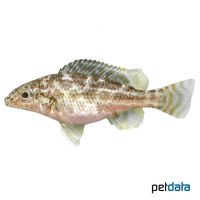Elephant-nose Cichlid (Nimbochromis linni)
| Elephant-nose Cichlid Nimbochromis linni | |
|---|---|
| Name | Elephant-nose Cichlid |
| Name Lat. | Nimbochromis linni |
| Family | Cichlids |
| Family lat. | Cichlidae |
| Order | Cichlids |
| Order lat. | Cichliformes |
| Origin | Lake Malawi |
| Habitat | Rocky intermediate zone |
| Diet | Carnivore |
| pH | 7.5-8.8 |
| Behavior | Predatory |
| Keeping | Harem |
| Care Level | Difficult |
| Reproduction | Mouthbrooder |
| Breeding | Moderately difficult |
| Life Span | 5-8 years |
| Protection | No |
| Metric Units | |
| Size | 20-25 cm |
| Temperature | 24-28 °C |
| Hardness | 10-25 °dH |
| Aquarium | 450 l |
| US Units | |
| Size | 8"-10" |
| Temperature | 75-82 °F |
| Hardness | 178-445 ppm |
| Aquarium | 120 gal |
Distribution and habitat
The proboscis polystigmas occur exclusively (endemically) in Lake Malawi and are widespread throughout the lake. They mostly stay in the transition zone from the rocky littoral to the sandy littoral, but also on steeply sloping rocky reefs.
Maintenance
The aquarium should have rocky structures reaching the water surface, with caves, crevices and shelters to provide hiding places and some robust plants, as well as free sandy areas with plenty of free swimming space.
There should be no detectable ammonia, ammonium or nitrite, and the nitrate level should not exceed 100 mg/l. To ensure the water quality and the oxygen content, a filter adapted to the aquarium size and a heater are required, as well as lighting for the species-appropriate day-night rhythm of the animals.
Diet
They are ambush hunters that feed on fish and invertebrates. According to their size, the food offer consists of insect larvae, worms, shrimps and fish, which is accepted without problems also in frozen form, supplemented with commercially available frozen special food mixtures for cichlids. High-quality dry food for cichlids (granules, pellets) is also well accepted
It is recommended to feed small portions several times a day. Regular and varied feeding promotes health and increases resistance. Only as much should be fed as is eaten in a few minutes.
Behaviour and compatibility
They should be kept in a harem, one male with several females. Only during the breeding season they behave territorially and aggressively. Keeping a harem is only recommended in a much larger and richly structured tank. They are assertive hunters, but can be socialized well with other large cichlids. Juveniles and too small fish are considered food
Basically, only compatible fish species with similar demands on water condition and water temperature should be socialized.
Sex dimorphism
The sexes differ clearly in coloration (sexual dichromatism). The male is much more colorful and has egg spots on the anal fin. The female is smaller and inconspicuous gray-brown spotted.
Reproduction and breeding
They are maternal mouth brooders. The female spawns up to 20 eggs on sand or a flat rock. After fertilization by the male, the female immediately receives the eggs in her throat sac for mouthbrooding and retains the fry in her throat sac even after hatching. After approximately 3 weeks, the fry are released. The female does not eat during the entire mouthbrood care period. The fry continue to be cared for by the female for about 10 days and are taken up in the throat pouch overnight or in case of danger before brood care ends.
Fry must be fed several times a day with special rearing food (Artemia nauplii). Breeding is hardly possible in a community tank, as the fry are easy prey.
Important
The Proboscis Polystigma hunt only mbuna juveniles in the wild. They lie in wait with their pied color pattern well camouflaged over crevices and cave entrances for young fish, which they suck in with their wide protruding mouth. At breeding time they lose their pied camouflage pattern, the male becomes dark blue, the female gray-brown and there is little hunting.
The well-being of the fish should be checked regularly. Temperature should be checked daily, pH, hardness and nitrate levels at least fortnightly. Regular partial water changes are recommended, even if the contaminant level has not yet reached the upper limit. Sudden changes in water quality should be avoided. Newly introduced fish must be accustomed slowly to the water in the aquarium.
Further literature can be found in your pet store.
References
Text: Werner Winter; Image: petdata
Source: BMELV (1998): Tierschutzgutachten - Haltung von Zierfischen (Süßwasser); RIEHL & BAENSCH (2006): Aquarien Atlas Bd. 1, Mergus Verlag; ENGELMANN (2005): Zootierhaltung - Tiere in menschlicher Obhut: Fische, Verlag Harri Deutsch
- Gemäß § 21 Abs. 5 Tierschutzgesetz idgF
